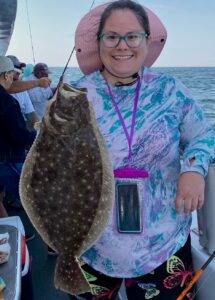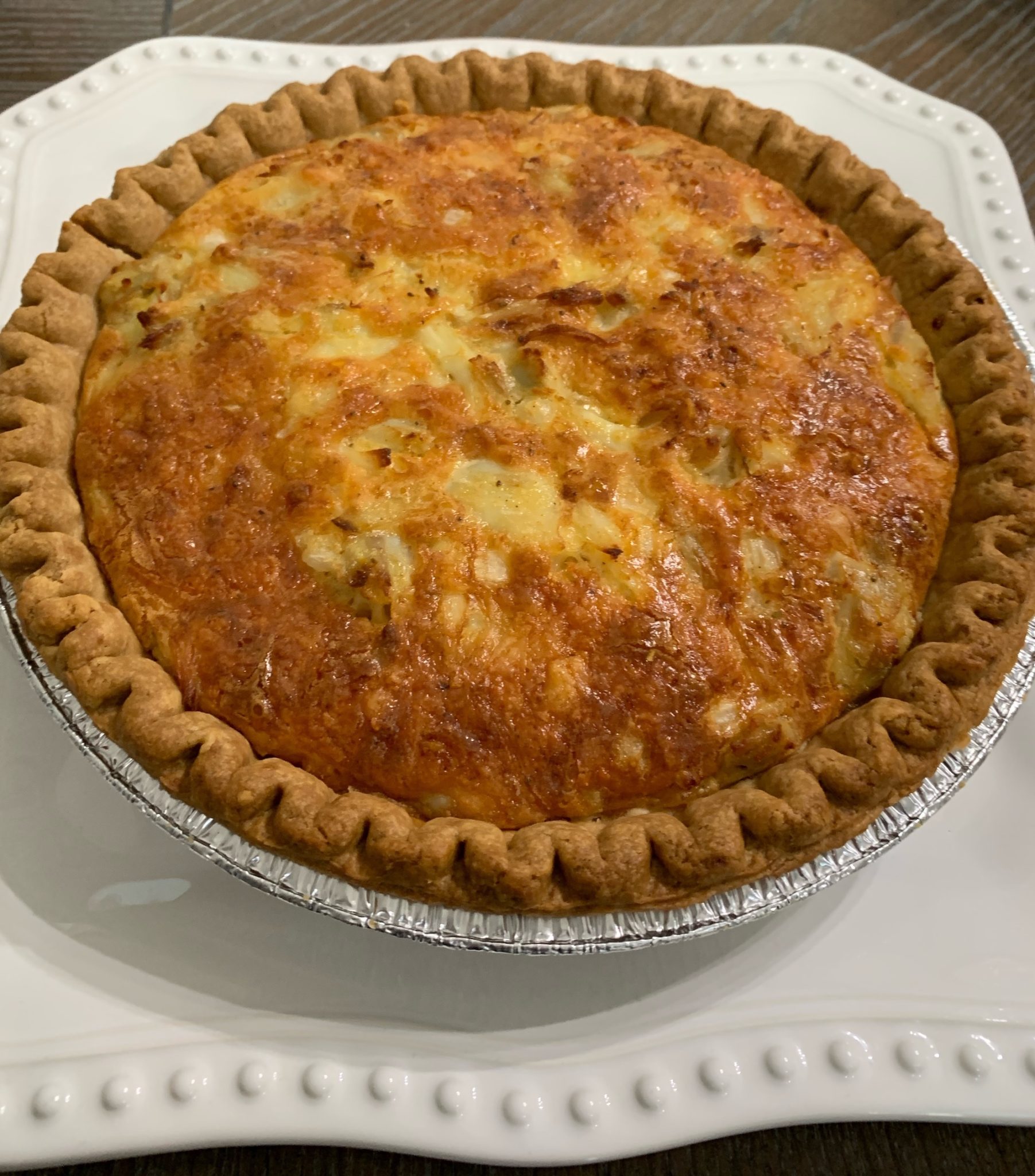
Posted on August 19th, 2023
Hit the vid for all that Atlantic Tackle has to offer!!
I just got back from a very busy 3rd and final day at the 2023 Poor Girls Open and it was an exciting time! There were lots of changes to the leaderboard and a bunch of money changed hands several different times. When I officially closed scales at 9:00 PM sharp, the crew of Fish in OC charter partner Reel Chaos with Captain Anthony Matarese Jr. was at the top of the leaderboard with four white marlin releases. They’ll win right around $100,000 for their efforts and a really great trophy as well. I’m certain that my old friend Captain Steve Harman is looking down at his tournament with joy watching his daughters, brothers and family run an awesome event….and I hope he’s happy with the job that I’ve done as emcee. I was one of many that helped Captain Steve put this tournament together almost 30 years ago so it’s got a very special place in my heart. I’m proud to see where it’s gotten and the lives it has impacted through millions of dollars in donations. Here are your 2023 Poor Girls Open winners!
Billfish Release
1st Place – Reel Chaos – 4 White Marlin Releases

2nd Place – Buckshot – 2 White Marlin Releases, 1 Blue Marlin Release

3rd Place – Christine Marie – 1 White Marlin Release, 1 Blue Marlin Release
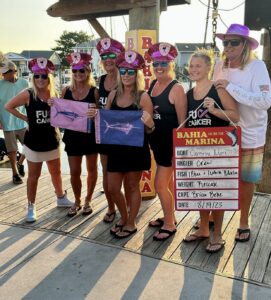
Heaviest Tuna
1st Place – Too Many Martinis – 68.5 Pounds

2nd Place – Game Over – 58.7 Pounds

3rd Place – Southern C’s – 58.5 Pounds
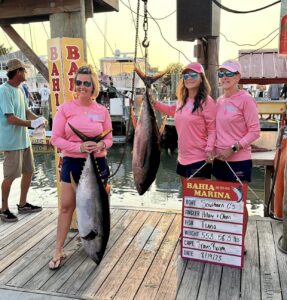
Heaviest Wahoo
1st Place – Mikks N It Up 56.6 Pounds

2nd Place – Jacked Up – 51.8 Pounds

Heaviest Dolphin
Southern C’s – 24.2 Pounds

2nd Place – Spring Mix II – 11.6 Pounds

3rd Place – Southern C’s – 10.8 Pounds

Jr Angler
Anna Deckelman – 1 White Marlin Release
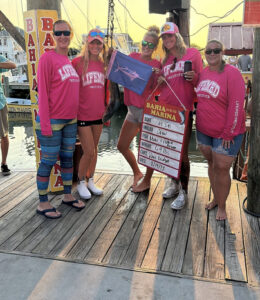
Outside of the tournament, Captain Monty Hawkins of the Morning Star had some flounder and sea bass and dropped reef block number 40,000 for the OCRF!!
Nice sunrise, ocean plenty calm nearshore despite a stiff NW breeze. Better still? Forecasts promised calmer & calmer seas as winds diminished around 8am. Ha! Anyone care to guess how accurate that was?Apparently noon was what they really meant.But, calm down it did. We were lucky really. While blowing 20 the wind switched just enough from NW toward N that it didn’t build much of a set after the morning burst. Past lunch it began getting pretty. We had a beautiful ride home. I imagine tournament boats fishing the Washington Canyon (65 miles south) were some thankful when the wind eased off. Would have been a nasty thrashing to come so far in a north wind. Considering recent days, I though us lucky too that sea bass bit fairly well – at least at first(!) A local fellow; Brice was even in double digits by 11:30. (got hung stopped at 13..) Though mostly targeting cbass, clients caught a few nice flounder also. Ron took the sea bass pool and Sam won the reef shirt with a nice fluke. (Have a TON of room for tomorrow’s XXL flounder trip in light southerlies. See morningstarfishing.com if interested. Looong 11 hour day. I know where some are – promise! email if after 8pm..) Always taking note at the thousand block mark, I made this post this morning. **** Reilly dropped reef block #40,000 just now. A truly inexpensive way to build reef over time; just 20 a day sure adds up. I pick spots on permitted artificial reef sites for deployments, usually where a reef is partially scoured in or an expanse of bare steel (a barge reefed on purpose for instance) needs something to break the current. Have also also built spots with just blocks and now pyramids to great effect. They all increase habitat for sea bass, summer flounder, tautog & squid. These fish grow to maturity and spawn on nearshore (not canyons) reefs and squid spawn on hardbottom reef the workd around.Today’s drop was at Capt. Bob Gowar’s Memorial Reef & makes 4,243 reef blocks & 90 boat deployed pyramids there. Crucial to this project are the companies that make it happen. York Building Products especially has given us over 20,000 blocks. For Pyramids we depend on concrete plants to fill our 2 man deployable pyramid molds. First created in late 2019, we’re approaching 4,000 pyramids either deployed by CCA MD on Chesapeake oyster sites, or OC Reef Foundation where they’ll eventually grow coral on our marine sites. Kinsley’s concrete plant in York, and Bear Concrete in Bear, DE have made most of these. We’ve also had several young men of late take it upon themselves to make pyramids. Roman, for instance, is approaching 70 pyramids for his project. Big money projects are coming. Barges, Tugs, a Landing Craft will all be deployed through fall. Reef building every day we fish is nearly free save trucking..******No good deed unpunished; my “Number Forty Thousand” reef block post was attacked by the Chairman of the Reef Ball Foundation. While I ‘like’ every single post of theirs that I come across–all reef building is good reef building in my book!– this world wide foundation guy is so sure my reef building methods (and the corals growing?) are lame that he’s taken to messaging me and commenting on a major post to stop what I’m doing and even messaged: “get with the program.” Heyyy.. Y’all ever seen an angry reef building fisherman? Done missed your chance! Mr. Chairman, a CNN Hero even, apparently wants “Reef Ball Only” reef restoration world wide and is willing to bash all my efforts and those of so many volunteers and donors who have given generously to get this huge restoration work started. I suspect he’s scared other reef builders with budgets that work for his product will see a way to build more reef with less money. A lot more reef with a lot less money. Seriously. Why else would an enormously successful foundation chair bother with a low budget operation like ours? I don’t even take a salary so we can use those monies for reef too. I gave away my reef ball molds to a local educational program when my mates had assembled 12 of my pyramid molds while I wasn’t but halfway done assembling a single reef ball mold. Too complex. For some, Time is Money. To me, Time is Reef. I’m trying to show any who will look that you don’t need special anything to grow reef. If it will stay put? It’ll work. Shoot, I bet there’s so many oysters growing on TNC’s concrete “oyster castle” blocks now in their Virginia Preserve that you could grow a fine reef with tennis shoes. Yes, sneakers. Seriously. There’s so much natural spat being thrown from their artificial reef constructions you could tie sneakers to a stout stick and build a reef. Skip the sneakers. Even sticks grow oysters down there. Fifteen years ago TNC estimated there were more oysters on their purpose built reef bottoms behind Virginia’s barrier islands than in all of the Chesapeake. I sure hope that’s no longer true owing something I’ve long promoted. The fed and states have had wonderful success using rock in recent years. Oyster restoration is a sure bet now. But not its timing. The ocean grows greener. Rolling rocks off a barge is only money.. (I used just over ten thousand of TNC’s castle blocks (some even with special cement) before the price shot up as Gulf disaster BP grant monies came on line. That’s when I started hunting ‘off inventory’ blocks. I soon found fish, mussels & coral didn’t much care if the cement was ‘special.’) Our best coral growth on purpose sited artificial reef (eg – not an accidental or catastrophic shipwreck which has, by far, our best corals) ..our best artificial reef growth to date is on tires. Yes, tires. I didn’t do it! These are at the Bass Grounds and were deployed in the ruinous 1970s mosquito control project that went from NY to TX at least. Instead of adding concrete as ballast, they were cut and banded with steel then weighted at either end. Hmmm.. Steel and saltwater.. What could go wrong?Folks at Assateague still pick those tires up after a heavy NorEaster or hurricane. If you look in the dumpster you’ll see where star coral had grown before the storm tore them free of the bottom. Of several large reefs built, the ones just inside the First Lump, (a tall shoal with only 20 of water over it just 9 miles off Maryland’s coast) ..the shoal breaks wave energy from even the most savage of storms off Ocean City. Thusly protected, those tires grew into a reef. It was probably the most heavily fished reef off Ocean City until the state built an even bigger tire reef 12 miles south (with rebar & cemented multi-tire units) from a NJ prison program in 1994. Prisoners, it turns out, used pieces of rebar to make deadly weapons. Then a ‘scientist’ (with no agenda, I’m sure) added just enough water to pulverized tire rubber that it formed a slurry. Shockingly, fish (and probably some prisoners) died ..and so did tire units. An easy target–a huge reef; it’s still one of our most heavily fished spots. No, I’m not an advocate of tire reef. Granite would be much better. Concrete is OK by this poor boy too. This idea a substrate has to be special – or ‘pretty’ – or even ‘natural’ like shell? Nonsense. Waiting for special (and the big funding special things need!) is WHY the ocean is still green. Not more blue. More green. Anything on the bottom harder than loose sand that stays put in a blow will grow oyster or temperate coral reef just fine. Indeed, we had a vast area of soft substrate – about 4.5 square miles of reef were lost in the 1960s & 70s when clamming gear pulverized a not-quite sandstone substrate most similar to marsh peat. You could crush it by hand. Square miles of incredibly productive bottom were were reduced to square yards. The substrate never had a chance against many-ton hydraulic dredges that liquify the bottom. I’ve been trying to put that bottom back since the late 1990s when I worked with local trawl skippers to get a huge Army Corp reef permit approved there. The work goes slowly when funded by spaghetti dinners, charts, t-shirts, and a few truly generous donors, but we are making progress. Surely we are. Even blocks 20 at a time have made a real contribution. The World Wide Reef Ball Foundation Chairman writes as if reef blocks are tumbling all about, are made of low quality cement, and that I’m teaching children reef restoration with a bad concept. The truth of it he claims? Blocks won’t work. Man.. Sure have caught a lot of fish atop em. I mean a seriously lot. And for a long time. One reef site in particular is not at all sheltered like those tires. I have built several block reefs (pyramids too later) at Jackspot Shoal where our reefs take an absolute pounding in a hearty blow. There were already over a thousand blocks at the east side of St. Ann’s Reef when hurricane Sandy passed off the coast. Just about every reef, natural or artificial, in less than 75 ft of water off DelMarVa had its sea whip stripped bare. Precious little soft coral survived. But our substrates, including blocks, remained on station. Then, owing deeper, more protected coral colonies that resumed spawning, everything grew back in time. Fish, of course, are just as happy with a mussel community as corals. Those grow back quite quickly. Here’s the difference in our thinking. I know we’re losing. The ocean has turned green. I want our estuaries full of oysters to fight algae and overnutrification. I want our seafloor as alive with corals as it was in 1950. We don’t need pretty substrates. It’s not an art contest. See Generals Powell & Schwarzkopf wait for the perfect Army? We need lots of substrate. We’re losing a Large Marine Ecosystem. We need to win this fight. Want perfect? Wait for a scientific approved product? Scientists approved tires too. (Too bad the engineering was a huge fail.) Special cement is a myth – dern near everyone making reef of any type gets a truck or mixes sackrete on site.Concrete is concrete so far as sessile reef building animals are concerned. We have the corals, mussels, oysters & fish to prove it. Ohhh Captain! But oysters neeeeed super special substrate to attach & grow. Baloney. The Woodrow Wilson Bridge Rubble at Curtis Johns Reef near Tangier in Chesapeake Bay has oysters growing like mad. Special what? Concrete? I don’t think so.. Ecosystem Restoration? Yes Sir! Get it done! Load Barges And Go!I believe restoring bluewater across nearshore grounds of the Mid-Atlantic; making marine waters atop shoals like Jackspot clear again; the famous places where marlin once fed in grand number 50 miles inshore of where they are caught today – I believe that enormous restoration project relies primarily on oysters. I know scientists list a host of other water quality issues; but where I’ve seen oysters in good number? I’ve also seen biofiltration at work making water clean & clear. Pretty & Special my foot. Use it all – every trick we have! Get to work! I want to see temperate coral reefs once measured in square miles replaced with today’s efforts -Now- not in another generation or another. Now. Soon. NOAA claims some fisheries are ‘restored’ with 85% and more of their habitat lost during the early industrial fishing period. How is that possible?Any population of fish is possible when government computers are fed enough catch estimate baloney. . . I do not care if it’s reef balls or pyramids; bridge rubble or substrate from absolutely vast scrap yards of precast cement that manufacturers will only have to pay to be crushed for road bedding. It does not matter. Temperate corals & oysters have no mind of what hardbottom they find. Any cement will do. In fact, granite would probably be best because it will last until plate tectonics gobble it up. Big and immediately productive – we’ll likely get just a couple generations from steel materials of opportunity such as barges & tugs. It all grows fish.It all grows coral. Huge-Huge-Huge granite reefs made with rock of all sizes creating rugosity in every measure: That could turn the ocean blue. Quickly I’d imagine. Same with concrete. Wait for perfect? Wait for pretty? The work will only get more and more difficult. But, heyyyy, maybe a large foundation will offer citations for giant jellyfish in hypoxic algae laden marine waters..Regards,Monty








